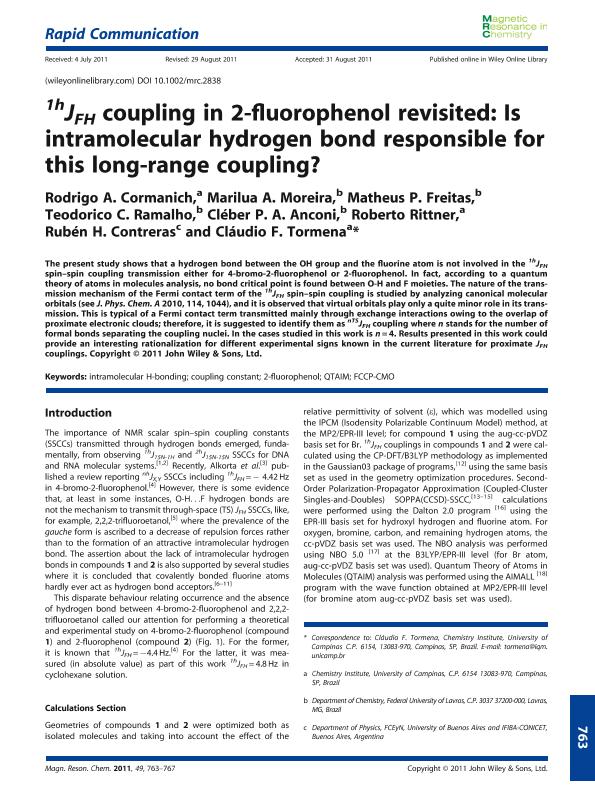Mostrar el registro sencillo del ítem
dc.contributor.author
Cormanich, Rodrigo A.
dc.contributor.author
Moreira, Marilua A.
dc.contributor.author
Freitas, Matheus P.
dc.contributor.author
Ramalho, Teodorico C.
dc.contributor.author
Anconi, Cléber P. A.
dc.contributor.author
Rittner, Roberto
dc.contributor.author
Contreras, Ruben Horacio

dc.contributor.author
Tormena, Cláudio F.
dc.date.available
2018-08-22T18:58:47Z
dc.date.issued
2011-11
dc.identifier.citation
Cormanich, Rodrigo A.; Moreira, Marilua A.; Freitas, Matheus P.; Ramalho, Teodorico C.; Anconi, Cléber P. A.; et al.; 1hJFH coupling in 2-fluorophenol revisited: Is intramolecular hydrogen bond responsible for this long-range coupling?; John Wiley & Sons Ltd; Magnetic Resonance in Chemistry; 49; 12; 11-2011; 763-767
dc.identifier.issn
0749-1581
dc.identifier.uri
http://hdl.handle.net/11336/56670
dc.description.abstract
The present study shows that a hydrogen bond between the OH group and the fluorine atom is not involved in the 1hJFH spin-spin coupling transmission either for 4-bromo-2-fluorophenol or 2-fluorophenol. In fact, according to a quantum theory of atoms in molecules analysis, no bond critical point is found between O-H and F moieties. The nature of the transmission mechanism of the Fermi contact term of the 1hJ FH spin-spin coupling is studied by analyzing canonical molecular orbitals (see J. Phys. Chem. A 2010, 114, 1044), and it is observed that virtual orbitals play only a quite minor role in its transmission. This is typical of a Fermi contact term transmitted mainly through exchange interactions owing to the overlap of proximate electronic clouds; therefore, it is suggested to identify them as nTSJFH coupling where n stands for the number of formal bonds separating the coupling nuclei. In the cases studied in this work is n = 4. Results presented in this work could provide an interesting rationalization for different experimental signs known in the current literature for proximate JFH couplings. © 2011 John Wiley & Sons, Ltd.
dc.format
application/pdf
dc.language.iso
eng
dc.publisher
John Wiley & Sons Ltd

dc.rights
info:eu-repo/semantics/openAccess
dc.rights.uri
https://creativecommons.org/licenses/by-nc-sa/2.5/ar/
dc.subject
2-Fluorophenol
dc.subject
Coupling Constant
dc.subject
Fccp-Cmo
dc.subject
Intramolecular H-Bonding
dc.subject
Qtaim
dc.subject.classification
Otras Ciencias Químicas

dc.subject.classification
Ciencias Químicas

dc.subject.classification
CIENCIAS NATURALES Y EXACTAS

dc.title
1hJFH coupling in 2-fluorophenol revisited: Is intramolecular hydrogen bond responsible for this long-range coupling?
dc.type
info:eu-repo/semantics/article
dc.type
info:ar-repo/semantics/artículo
dc.type
info:eu-repo/semantics/publishedVersion
dc.date.updated
2018-08-21T14:27:53Z
dc.journal.volume
49
dc.journal.number
12
dc.journal.pagination
763-767
dc.journal.pais
Reino Unido

dc.journal.ciudad
Londres
dc.description.fil
Fil: Cormanich, Rodrigo A.. Universidade Estadual de Campinas; Brasil
dc.description.fil
Fil: Moreira, Marilua A.. Universidade Federal de Lavras; Brasil
dc.description.fil
Fil: Freitas, Matheus P.. Universidade Federal de Lavras; Brasil
dc.description.fil
Fil: Ramalho, Teodorico C.. Universidade Federal de Lavras; Brasil
dc.description.fil
Fil: Anconi, Cléber P. A.. Universidade Federal de Lavras; Brasil
dc.description.fil
Fil: Rittner, Roberto. Universidade Estadual de Campinas; Brasil
dc.description.fil
Fil: Contreras, Ruben Horacio. Universidad de Buenos Aires; Argentina. Consejo Nacional de Investigaciones Científicas y Técnicas. Oficina de Coordinación Administrativa Ciudad Universitaria. Instituto de Física de Buenos Aires. Universidad de Buenos Aires. Facultad de Ciencias Exactas y Naturales. Instituto de Física de Buenos Aires; Argentina
dc.description.fil
Fil: Tormena, Cláudio F.. Universidade Estadual de Campinas; Brasil
dc.journal.title
Magnetic Resonance in Chemistry

dc.relation.alternativeid
info:eu-repo/semantics/altIdentifier/doi/http://dx.doi.org/10.1002/mrc.2838
Archivos asociados
